
Guide to SMS for Ecommerce in 2022: Resources, Checklists, and Examples
The Rise of SMS Marketing in Ecommerce
While email newsletters and Instagram ads can be great for engaging with your target audience, SMS marketing is an excellent channel to galvanize your brand's biggest, most loyal fans.
Just ask Wine Library, Gary Vaynerchuck’s family business. In 2011, the company was pulling in nearly $67 million in annual sales. That same year, Gary left the family company and went on to create VaynerMedia. After his departure, Wine Library's sales plummeted—and the family asked Gary to help them course-correct.
So, Gary recruited some help from his VaynerMedia team. Their solution: WineText, an SMS-based marketing and commerce channel. Users opt into WineText on Wine Library's homepage, providing a few key details: name, address, phone number, and payment data.
The team sends a daily deal to the entire list, and according to Vaynerchuk, those nearly 9,000 SMS subscribers consistently outperform Wine Library’s email list of 400,000 by a magnitude of 9x.
Sure—not every customer wants to receive texts from every brand they do business with. But for the brands they feel most connected to, they may have no problem receiving real-time updates on the device they check more than 80 times per day. In fact, they may want to. When done strategically, building an engaged text message marketing community can generate millions in revenue.
“I can't stress the importance of SMS marketing enough because of how astounding the numbers are in comparison to email,” said John Lim, CEO, AZN FLUSH. “On average, a great email list will get 20% open rate and a 2% CTR. We're seeing closer to 90% open rates on SMS and 20% CTR. Those clicks aren't just visits either. We're seeing great conversion rates and, on a per message basis, SMS is outperforming email for us.”
This is the type of success Vaynerchuck tapped into for Wine Library years ago. Today, you can do what once was exclusive to Wine Library without having to custom code anything — if you are on Shopify, at least. Enter: Postscript.
In addition to empowering brands to engage with, and market to, their biggest fans via text, Postscript offers an integration with Recharge. This allows customers to purchase by simply replying to a message.
But before you go and set this up for your brand, take caution. “All brands should not jump on this bandwagon,” said Postscript President and Co-founder Alex Beller. “However, any brand with subscriptions, natural reorder cycles, or drop strategies should lean in here. Engagement rates are too high to ignore.”
Dennis Yu, CEO at BlitzMetrics, agrees. He says making text messages from brands feel fun and informative, like communication from friends, is key—rather than using it as a medium for a barrage of coupons, promos, and other sales tactics.
“The issue is not about SMS as an extension of email blasting, but about producing content that's worth sharing, in this case, through short text-based messages.”
The Basics: SMS Marketing Questions and Answers
That all sounds great, but let's take a step back and answer some foundational questions about SMS marketing for ecommerce before we go too in-depth on adopting it for your brand.
How do you do SMS marketing?
Effective SMS marketing for ecommerce brands requires a strategy. This is a channel that can 10x revenue when done right. That means compliantly growing a list, setting proper expectations, building trust, and more.
How can I grow my SMS list?
Ecommerce brands can grow their SMS marketing list through popups on their website, as well as text-a-keyword programs that can reach subscribers on non-owned channels like social media.Is SMS marketing effective?
SMS marketing for ecommerce brands is incredibly effective. 98% of text messages are read by the end of every day, and 32% of consumers respond to SMS marketing from a brand (in comparison to email marketing’s 20% open rate and 2% clickthrough rate).
How do you set up text marketing?
Setting up SMS marketing for ecommerce brands can be incredibly easy with tools like Postscript, which offers pre-built text message nurture flows, assigns phone numbers, and more.
How can SMS be used for ecommerce?
Ecommerce brands can use SMS marketing for net new customer acquisition, repeat sales through VIP and loyalty programs, and distribution of important information like new promos, drops, and more.
What types of texts can be sent to customers for SMS?
You can send pretty much any type of text message to customers, but you’ll want to be as on-brand as possible. You should also be mindful of not sending too many messages in a short period of time. Some of the best types of texts to send include conversational texts (i.e., when a customer has initiated the outreach and is looking for information), birthday or anniversary messages, and reward program updates.
We’ll break all of that down even further here. This new channel is still in its infancy, and we already know what early adopters on Facebook ads or with 1-click technology were able to achieve: a massive leg up in their market.
With that in mind, here's an outline of everything covered in this article.
In this article (click to jump to a specific section):
How can you use SMS marketing to improve customer experience?
3 Tools and Technologies to Automate SMS Marketing for Ecommerce
How can an SMS automation platform for ecommerce help brands scale with text messaging?
Why are ecommerce marketers embracing SMS marketing?
Ecommerce marketers are embracing SMS marketing because engagement rates are high, because consumers and customers say they prefer text (when it's relevant, of course), and because there is still room in the market for more brands to use this channel.
In other words, there is active engagement and lower saturation than a channel like email marketing or Facebook advertising. Even though 60% of SMS users already receive spam messages once a week, and 28% receive one a day — there is a way to build a loyal customer base through SMS (and not be considered spam at all).
Just look at the numbers.
1. Consumers are already on their smartphones (and in their text messages).
98% of text messages are read by the end of the day. (TextLocal, 2017)
74% of consumers report having zero unread texts, and only 4% report having seven or more unread texts. (Zipwhip State of Texting Report, 2019)
2. Consumers say they prefer it, and few ecommerce brands are embracing it.
Multiple industries have discovered the value of business texting, with the highest use in real estate (73%), agriculture (65%), entertainment and leisure (63%), and construction, machinery and homes. (Zipwhip)
76% of consumers said they’ve received some kind of text message from a business. (Zipwhip)
67% of people would rather text with a business about appointments and scheduling instead of communicating by email or phone call. (Zipwhip)
Only 22% of users will read a text from a business they’re not familiar with and have not given their mobile number to. (TextLocal, 2017)
32% of consumers respond to promotional text messages from retailers. (TextLocal, 2017)
48% of U.S. consumers prefer SMS loyalty communication over direct mail, email, or application loyalty communications. (eMarketer, 2016)
Nearly 35% of consumers prefer to receive coupons and promotional codes from retailers via text message. (CodeBreaker Consumer Mobile Engagement Report, 2018)
3. Engagement is ridiculously high.
SMS engagement rates are six to eight times higher than email marketing engagement rates. (Retail Dive, 2018)
67% of consumers believe delivery updates are the most effective SMS messages, followed by order confirmations (64%), appointment reminders (64%), calendar reminders (54%), and promotional coupons (49%). (TextLocal, 2017)
Ecommerce Examples: How Brands are Using SMS
Based on the numbers above, it is clear that SMS for ecommerce can be perhaps best used to increase loyalty and grow revenue as a result. After all, increase LTV and your LTV-to-CAC ratio looks better and better.
Let’s look at how SMS marketing works across three distinct channels: acquisition, sales, and promotions.
Acquisition
Cloudy has developed a line of products that help people relax and get better sleep. John Robb, the Founder, needed a way to gain new customers while also offering support for people who had already purchased.
After just seven months, Cloudy had over 133,000 SMS subscribers. ROI skyrocketed up to 12x, and 16% of abandoned carts were recovered using SMS.
Sales
310 Nutrition's passion is helping customers improve their lives by providing proven solutions that fit their lifestyle. They help customers develop clean eating habits, stay active with the support of an engaged community, and start the journey to healthy living.
One big barrier to improving your life and changing habits? Time and convenience. To solve this for their customers, 310 Nutrition looked to SMS marketing. Their team wanted to explore SMS as a marketing channel, but needed to see great returns without dedicating much bandwidth. After all, a lot of ecommerce brand teams are small and bandwidth is limited.
So, they set up a Reply-to-Buy texting automation that integrated with their existing tech stack (Shopify, ReCharge, CartHook, and Gorgias). The SMS channel quickly began generating an additional $100,000 in revenue per week. They saw a 59X return on investment, and made $2.65 per text message sent.
Promotions
UMZU takes a different approach than Cloudy or 310 Nutrition. They are using SMS marketing to engage customers, educate them, and drive additional revenue through promotions. Since turning the SMS channel on, they’ve seen an increase of $87,000 in monthly revenue.
“Since installing this we've opened an entire seven figure-a-year revenue stream we didn't have before, instantly,” said Britney Elbert from UMZU.
How can you use SMS marketing to improve customer experience?
At the very least, when it comes to SMS marketing for ecommerce, you should implement SMS updates on shipping and delivery.
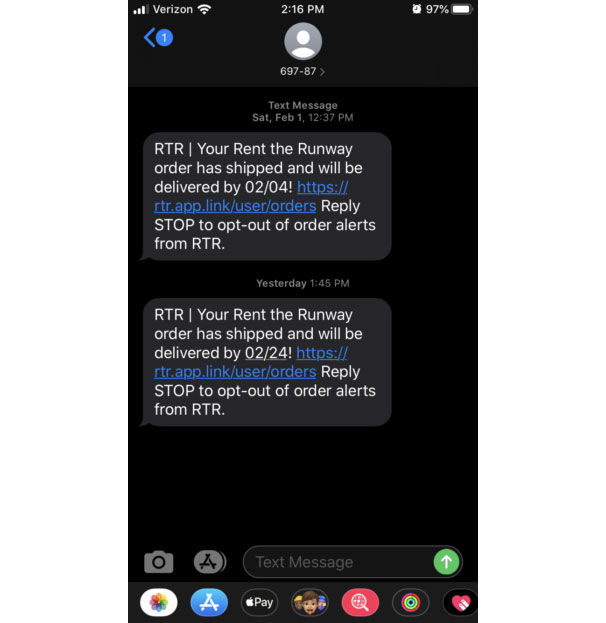
An automated shipping SMS message from Rent the Runway.
This kind of information is non-intrusive and incredibly relevant to customers. Plus, it reduces customer service needs, thus decreasing the number of customers calling or emailing in about where their package is.
Beyond that vital information, here are a few other ideas on how you can use SMS marketing to improve your customers' experience and create raving fans.
1. Conversational SMS Marketing
This is likely the absolute best type of SMS marketing ecommerce brands can do. You can use it for VIP customers, for re-ordering, or for customer service itself.
The key to this type of SMS marketing strategy is to build it into your entire funnel. Casey Armstrong, CMO at ShipBob, points to Verb Energy bars as a great example of this.
“Verb Energy is doing an amazing job with SMS marketing right now and they are thinking through the entire buyer's journey. From your first order, all communication is done through SMS. If you run out of their energy bars, just text them. They have their phone number on all of their bars, so if you want to try some or are bored and need somebody to text, you can message them. They reply in a very conversational way and are not overly salesy, which is a must. The medium is the message and SMS as a medium is typically reserved for friends, so treat this channel accordingly.”

Verb isn’t alone in this, either.
“Grinds, 310 Nutrition, Redline Steel, NaturAll Club. All of these brands are using SMS in a way that is conversational and embraces the VIP, two-way nature of interacting with customers for both support and sales,” said Sean Wendt, Head of Revenue Operations at Postscript. “Email and other channels are one-way, and the best SMS brands will take advantage of conversations at scale and make the buying and support process easier for customers that want to text instead of email or being tied to a website live chat.”
2. Reminders and Celebrations
Data is clutch in making this type of SMS marketing for ecommerce brands work. Figure it out, though, and you’ll reign supreme in your customers' minds as a brand that helps them remember when they are low on items—as well as when important life events are coming up.
Alex Birkett, Growth at HubSpot and Co-founder at Omniscient Digital, can’t get enough of how Daily Harvest is implementing this strategy.
“Daily Harvest is my favorite example because it's so value-based,” Birkett said. “I really enjoy getting their messages. They aren't overly cutesy or clever. They're not pushy or salesy. They just help me to remember when I can update my weekly subscription delivery, which, for the type of product they sell (food boxes), is incredibly useful.”
But what if you aren’t a subscription brand, and you don’t have any product-based reminders to send? No problem. This is where birthdays and celebrations come in, said Aaron Orendorff, VP of Marketing at Common Thread Collective.
“Native and Pura Vida Bracelets each execute SMS masterfully,” Orendoff said. “Unlike their email lists (where brands can get away with more frequent communication), I only get texts for (1) major product releases (as related to my previous orders), (2) major sales, and (3) major events in my life (e.g., my birthday and the anniversary of my first purchase). Huge hat tip to Pura Vida on that last one. That basically nets out to one text every 2-3 months for each company, outside of order confirmations and shipping notifications.”
3. Rewards Programs and Sales
You’ll want to be careful with how you message rewards programs and sales using SMS, but it can work.
Ecommerce writer and researcher Kaleigh Moore points to American Eagle as a great example of a brand using SMS to share updates about upcoming sales that aren’t annoying or spammy.
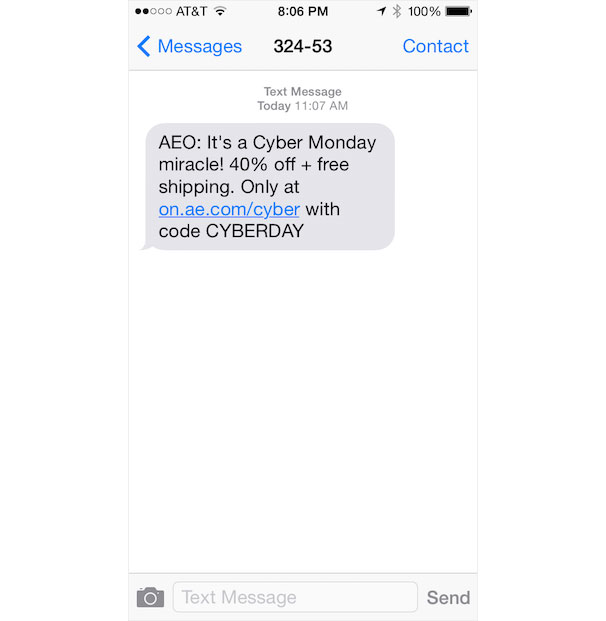
By tying the sale to a specific event, you are giving customers relevant information.
Hot tip: Make that code specific to the SMS campaign so you can track success against other channels like email or social media.
3 Best Practices and Strategies for SMS Marketing
Great, so you have a few ideas of how you can use SMS marketing to send information and updates to your customers. You even have some best-in-class examples of brands that are already doing it so you can subscribe and keep track of what you like and don’t like.
Now, let’s talk about how you can put together an SMS marketing strategy for your own ecommerce brand.
A Word About Compliance
As our world becomes more and more mobile, as consumers get more and more comfortable with mobile payments, and as VR and AI drive more of our experiences, data and how brands manage it becomes an important consumer topic.
We already see this happening in the news and around the web. And Gen Z is going to be a generation well-versed in their digital data rights.
So, before you even begin to think through an SMS marketing strategy, start with compliance.
“To stay compliant with TCPA and other laws, it is very important that you only send to subscribers who agreed to be sent SMS messages in the first place,” said Eric Carlson, Co-Founder, Sweat Pants Agency. “Also, it is important to update your privacy policy about ways you may communicate and let consumers know how they can opt-out. Keep your messages kid friendly, too. No profanity. No violence.”
How Postscript Helps with the Heavy Lifting
Postscript helps you save time by automating TCPA compliance. Specifically, Postscript provides:
Copy-and-paste TCPA compliant language to update your Terms of Service & Privacy Policy.
Tools and language to ensure you're receiving proper consent at checkout.
In-conversation opt-in confirmations and opt-out prompts.
Automated waking hours and overnight automation delays.
Double opt-in technology.
Automated opt-out and unsubscribe processes (e.g., Reply "Stop" to unsub).
Pre-built, compliant popups and sign-up forms.
1. Set expectations and start small.
As mentioned earlier in this article, the best way to make SMS marketing work for your ecommerce brands is to set appropriate expectations.
“Push SMS deep into the funnel as a retention or post-purchase support channel,” said Aaron Orendorff, VP of Marketing, Common Thread Collective. “Integrate it with shipping and fulfillment first — much like Facebook Messenger — so it becomes a natural place for relevant information. Only after establishing it as a genuine place for helpful — and human — interaction should brands then begin to leverage it for personalized upsells, reorders, and loyalty programs.”
This means that there are four steps to getting starting with an SMS marketing strategy:
Begin building your list by placing compliant opt-in sources throughout the customer journey.
Turn on transactional messages like SMS shipping and delivery updates and order confirmations.
Enable post-purchase customer support flows like, “How are you liking your purchase?”
Launch basic marketing flows like a welcome series and an abandoned cart. In welcome messages, be sure to communicate how the channel will be used. For example, will you be sending important updates, VIP drops, or something else? This is where you begin to set expectations.
This is important, because you're setting the tone for how your brand communicates with the customer. Start here, and it won’t be so jarring when you send additional information later.
“Test the waters with newly acquired customers,” said David Tendrich, Co-Founder, Sweat Pants Agency. “For newly acquired customers, you're setting the pace of the relationship at the beginning, so they know to expect that communication from you going forward."
2. Determine when and why you will message.
Will you be one of the brands that sets up conversational SMS marketing? If so, will you use bots or people to manage it? How will you fund that? These are all important questions to think through as you set up your SMS marketing strategy.
If you aren’t going the conversational SMS marketing route, then beyond order confirmation and shipping and delivery information, what will you send — and when?
Will you update folks on their birthday? How will you collect that data?
Will you send updates on the one-year anniversary since their first purchase? How have you built their loyalty over time to even appreciate that message?
What about customer service and re-orders? How will that work through SMS? Can they message you, or is it one-way?
“Focus on quality over quantity,” said Sean Wendt, Head of Revenue Operations at Postscript. “Using integrations and segmenting to text people based on their behavior with your brand matters because everyone reads every message. Treating SMS like email is a fast track to unsubscribes and lost loyalty.”
3. Build your list and get compliant opt-ins.
A huge part of your SMS marketing strategy is determining how to build your SMS list and collect compliant opt-ins.
One big thing to remember here is that building an SMS list is similar to building an email list, but the purpose and cadence of communication are very, very different.
“Remember that SMS is a more intimate channel,” said Andrew Capland, Head of Growth at Postscript. “Segmentation and list management is incredibly important. People will see your texts. So making sure you send your content to the right cohort of subscribers is incredibly important.”
Let’s look at a few ways to build the list, and how to use these various lists as a baseline SMS marketing segmentation strategy.
Website Popup
Perhaps the easiest way to build your list, website popups (on both desktop and mobile) are a quick way to capture subscribers, especially if you sweeten the deal with a special offer like a percentage discount. Here's a great example from Go Big:

Post Purchase
We’ve already covered this a good bit as a best first place to start. You can do this easily in Shopify or Shopify Plus, with a few different steps for each. Remember, as you collect SMS numbers, it is important that you do 3 things very clearly and very well:
Request that the customer sign up for marketing updates.
Explain that the customer will be receiving text messages from you in a TCPA-compliant manner, meaning that they acknowledge and agree: (a) to receive automated, recurring marketing messages to the consumer’s mobile phone number; (b) which may involve the use of an automatic telephone dialing system (“ATDS”), and (c) that consenting to receive such messages is not a condition of purchase.
Request that the customer provide their phone number in order to receive the text messages.
A great place to do this is at checkout. You can, and should, use the following messaging (or some variation of it) at checkout when collecting information to notify the customer of what they are signing up for:
I agree to receive recurring automated text messages at the phone number provided. Consent is not a condition to purchase. Msg & data rates may apply. View our Terms of Service for details.
Here is what it looks like in practice:
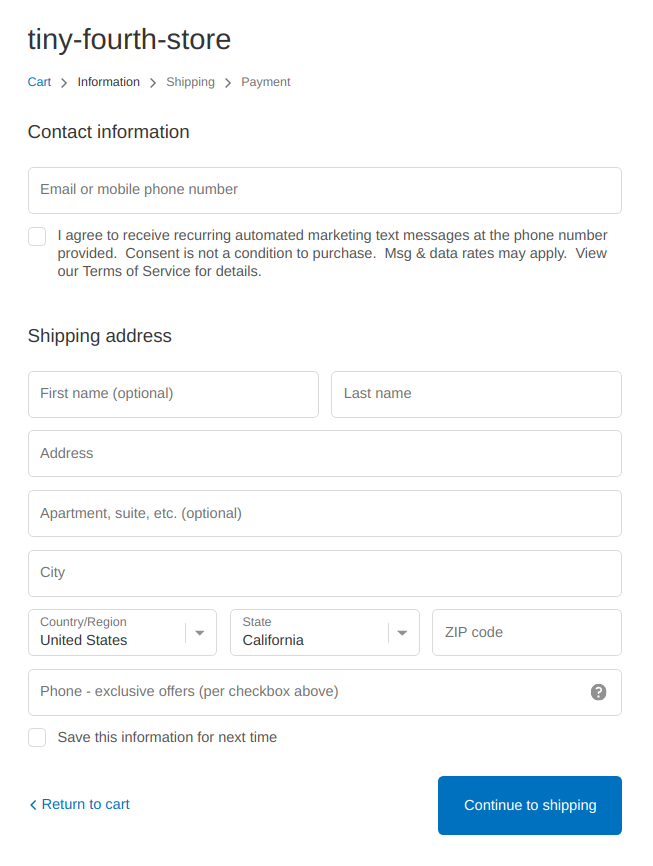
Surprise! You can build your SMS list using your already existing email list. Simply use a smart link in your email and let folks sign up if they are interested in that as a messaging channel. Be clear here, both in visibility of this option in your email as well as in what you will message to people.
You want them to want to get your messages, not to be surprised (i.e. annoyed) by them. Here are two examples from two very different brands (Olipop and STAUD) to give you an idea of what this may look like.


Set this up for your brand right now, right here.
One-click Mobile Popup
Have a specific landing page or blog post on which 80% or more of your traffic is coming from mobile? For a lot of sites, that is true for nearly their entire site. For those pages, or for the site in general, it makes sense to have a one-click-to-opt-in mobile pop up.
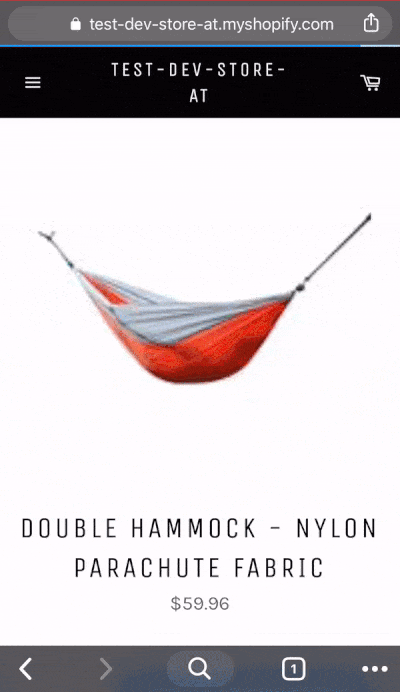
These pop-ups can be customized for specific pages as well as offerings. For instance, you can have a pop-up on a product page for a discount, or on a blog post page for a product announcement.
Click-to-text
Now, we know that online marketers have about 3 seconds to capture someone's attention and encourage them to take an action. This makes convenience and ease the name of the game in boosting sign-ups and engagement.
This is where click-to-text opt-ins come in. These types of SMS marketing opt-ins only require two taps, like the example above.
Or, you can simply tell potential and existing customers to text a keyword to a certain number.

You can then use that CTA on social media, in emails, on your site, on mailers, on TikTok — wherever you want.
Managing, Measuring, and Optimizing SMS Marketing Campaigns
Great! You have a strategy in place! Now, how do you know it is working? Let’s talk through KPIs for SMS marketing.
In general, KPIs for SMS marketing are similar to email. You can measure open rates, clickthrough rates, and opt-outs. There is one big difference here, though. You should set goals for open rates and clickthrough rates much higher than you do for email marketing.
“Your open rates need to be north of 40% if you have decent content,” said Dennis Yu, CEO, BlitzMetrics.
Additional KPIs to look at are Revenue and EPR, or earnings per recipient. This information will help you to better predict revenue growth and impact from this channel, which will in turn help you build a case for increased investment in it as it grows.
Managing and Respecting Opt-outs
Similar to email marketing, you will undoubtedly have folks who no longer want to be a part of your SMS marketing channel. That’s okay. Just make sure that from the moment they let you know that, they no longer receive SMS communications from you. This is part of SMS marketing compliance.
Platforms like Postscript make compliance incredibly easy for marketers thanks to opt-out automation. As soon as someone sends STOP to your account, they will no longer receive your SMS messages.
In fact, if someone messages you any one of the variants below, they will be unsubscribed. These are known as “fuzzy” opt-outs, and tools like Postscript take care of these for you as well.
Fuzzy Opt-Out Keywords
STOP
stpop
stpo
end
unsubscribe
cancel
do not text
do not call
don't text
don't call
take me off
wrong number
remove me
***k you
***k off
eat ***t
do not contact
don't contact
do not message
stop texting
stop ****ing texting
unsubscribe me
stop sending texts
stop sending me texts
Stop the text, please!
Stop sending me text message! I have asked many times and you continue to send them to me!
Stop 🛑
STOP SENDING ME THESE TEXTS... I already ordered one and I don't want to keep getting texts from you
Please remove. Thanks.
Stop all texts to me!
Please delete me from your text list. Thanks so much!
Stop sending me text
Stop sending these, please!
Remove this number
Do not text
Remove my phone number
Stop all
Quit texting me you already ripped me off
Please remove my number from your system. Thank you!
3 Tools and Technologies to Automate SMS Marketing for Ecommerce
The goal for any good marketing strategy, SMS marketing included, is to build it into your existing tech stack. This is because data is the currency of our age, and for SMS marketing in particular, the oil that makes it run smoothly.
You’ll need to connect it to your CRM or ecommerce platform (or both!) so you can send the right messages at the right time, monitor how often you're sending messages so you don’t overwhelm folks, keep a finger on the pulse of cohort open rates, clickthough rates and opt-out rates, and measure revenue from various SMS campaigns (likely by cohort).
In other words, good SMS marketing automation tools allow you to trigger messages based on events, have pre-built recipes and workflows, and sync all data and activity into the single source of truth you are already using.
There are three ways brands can go as they integrate and automate their SMS marketing strategies and flows.
1. Totally Custom
A totally custom SMS marketing build out is what Vaynerchuk used for WineText. In fact, this is what most brands used up until only a few years ago, because there weren’t any SMS tools available in the market.
You build a custom SMS tool using an API from Twilio or AWS. Because it is totally custom, this option puts a lot of work on your development team. Nothing is pre-built (there are no automation templates, for instance).
When would this option even make sense? Not often — but if you are using a completely custom tech stack, and are needing incredibly unique automation and data integration customizations, then this option might be for you. Be sure to scope this out with your development team or development agency. The cost can grow quickly, and you’ll want to follow through multiple QA tests to ensure it works the way you intend.
2. Mass Texting Solutions
The first SMS marketing solutions to hit the market were mass texting solutions. They took the need for custom builds off the table, giving brands the ability to not have to start from scratch.
But these solutions don’t often come with integrations into ecommerce backends, nor with automations specifically for ecommerce needs. Instead, many of these were built specifically for B2B businesses.
A few examples of early mass texting tools to hit the market are BulkSMS and SendHub.
3. Ecommerce SMS Marketing Automation Platform
Ecommerce SMS marketing automation platforms are literally built for ecommerce brands. They have pre-built automations specifically for ecommerce brand needs, prioritize compliance so brand marketers don’t have to get too deep into the technical work, and are often built as SaaS solutions, which means any updates made to the platform can be used by all brands using the tool.
This kind of build is what Postscript is, and follows a similar build out to Mailchimp or Klaviyo. Those tools integrate easily with the ecommerce tools you are already using (likely Shopify), but also have easy to tap into APIs that can be used for more custom needs on Magento, for example.
This means that you can easily scale, pay a low monthly fee, and get all the benefits of a purpose-built solution so you don’t have to re-create the wheel.
“We use Postscript with several of our ecommerce brands, and integrate with Klaviyo (email subscribers), privy (for pop-ups) and Gorgias (for customer service),” said Eric Carlson, Co-Founder, Sweat Pants Agency.
How can an SMS automation platform for ecommerce help brands scale with text messaging?
Similar to email marketing, SMS marketing has a lot of upfront work needed in order to set it up properly. And, it needs quarterly monitoring and measuring to make sure that your messages are effective.
But once you set up your SMS marketing strategy and measure it appropriately, the scalability is endless.
“Any serious marketing team has already invested in email automation. The reasons there are obvious (tracking, automation, time savings, and increased ability to optimize),” said Alex Birkett, Growth at HubSpot and Co-founder at Omniscient Digital. “The same should apply for brands who are serious about making SMS work at scale. A proper platform helps you measure, scale, and ultimately optimize and improve your campaigns, resulting in increased ROI.”
4 Scalable SMS Marketing Automations and Recipes
It’s important to note that you cannot send texts to customers whose phone numbers you already have, but didn’t collect as part of a compliant SMS marketing strategy. The good news is that tools like Postscript help to make sure you follow those rules.
That said, here are the top four SMS marketing automations that scale your list and your SMS marketing revenue from day one.
1. Abandoned Cart
Customize these messages however you want, but the recipe for Abandoned Cart SMS marketing is already built-in and ready for you in Postscript.
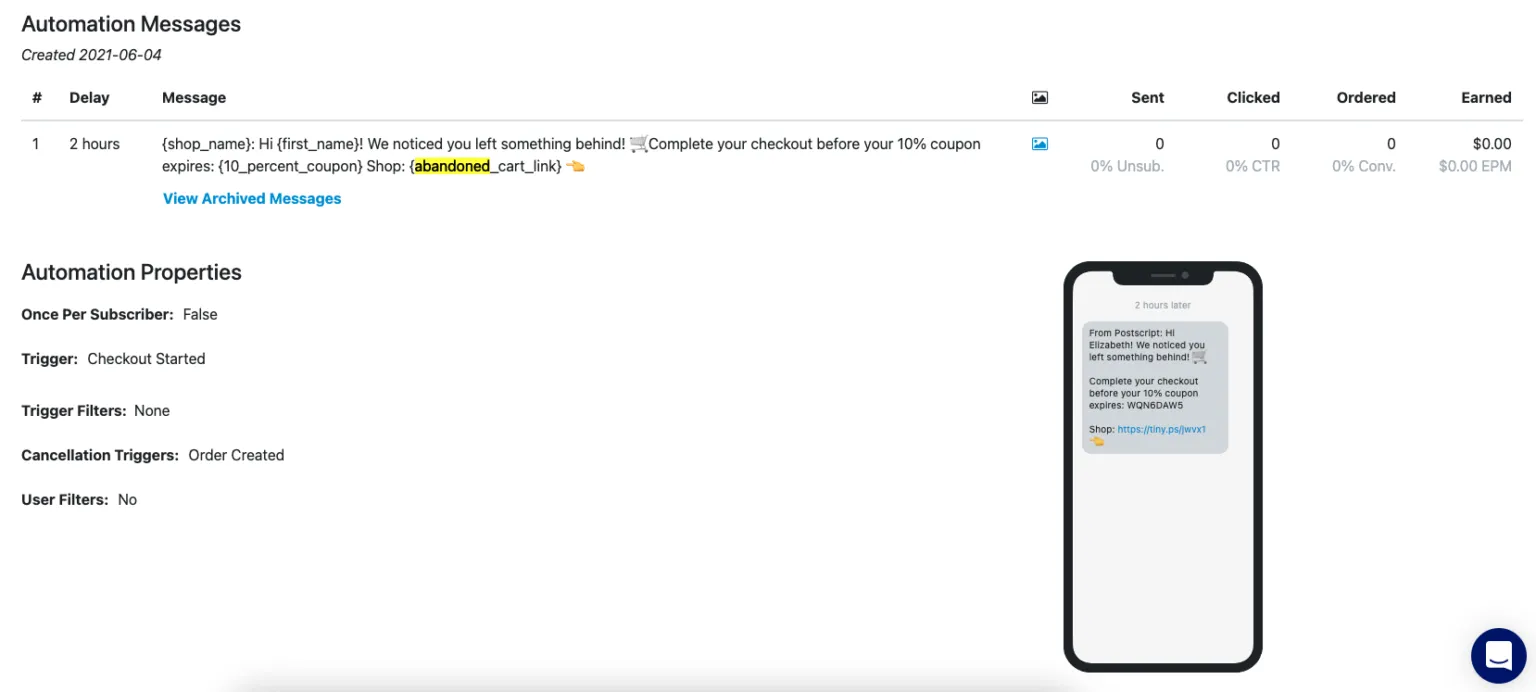
Tracking and measurement is also located here to make sure you have a handle on what is working, and how well.
2. Loyalty Offer
The Loyalty Offer is another great SMS approach to launch on day one. Again, customize the messaging however you want, but the workflow is already built out for you, including measurement of the campaign.
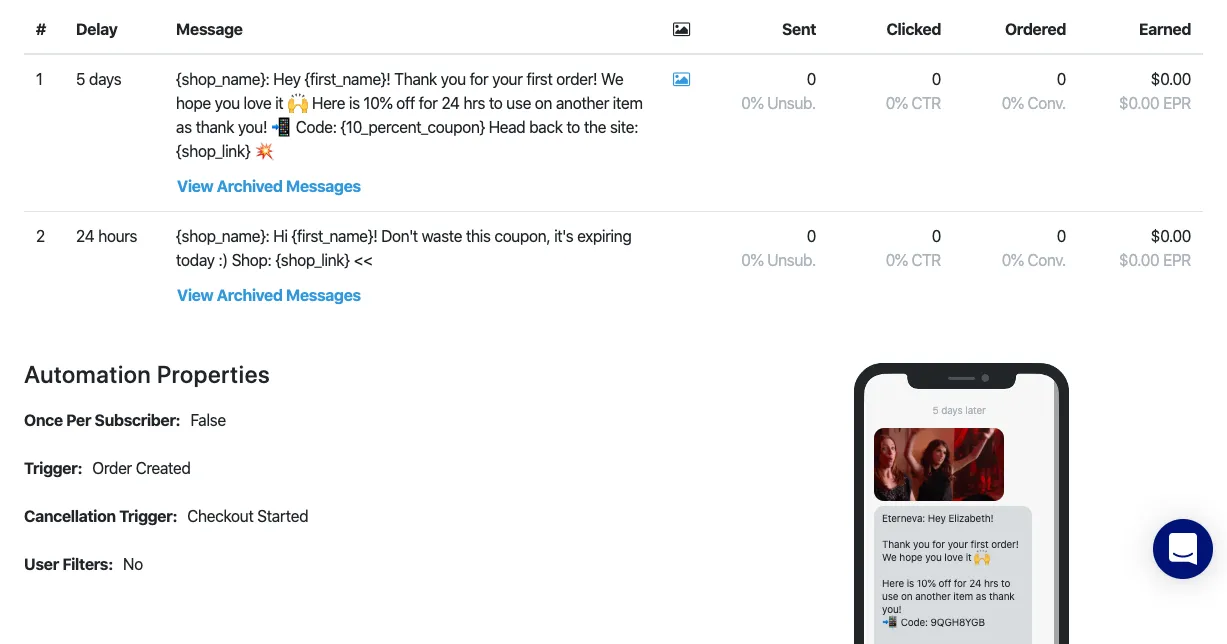
You can easily include GIFs in these to make your messages feel more friendly and branded.
3. Shipping Notifications
If you are using Shopify, you likely already have these shipping notifications turned on. The problem with Shopify’s built-in solution is that you can’t see engagement rates, success, etc. Simply turn this pre-built template on to take the place of the Shopify flow.
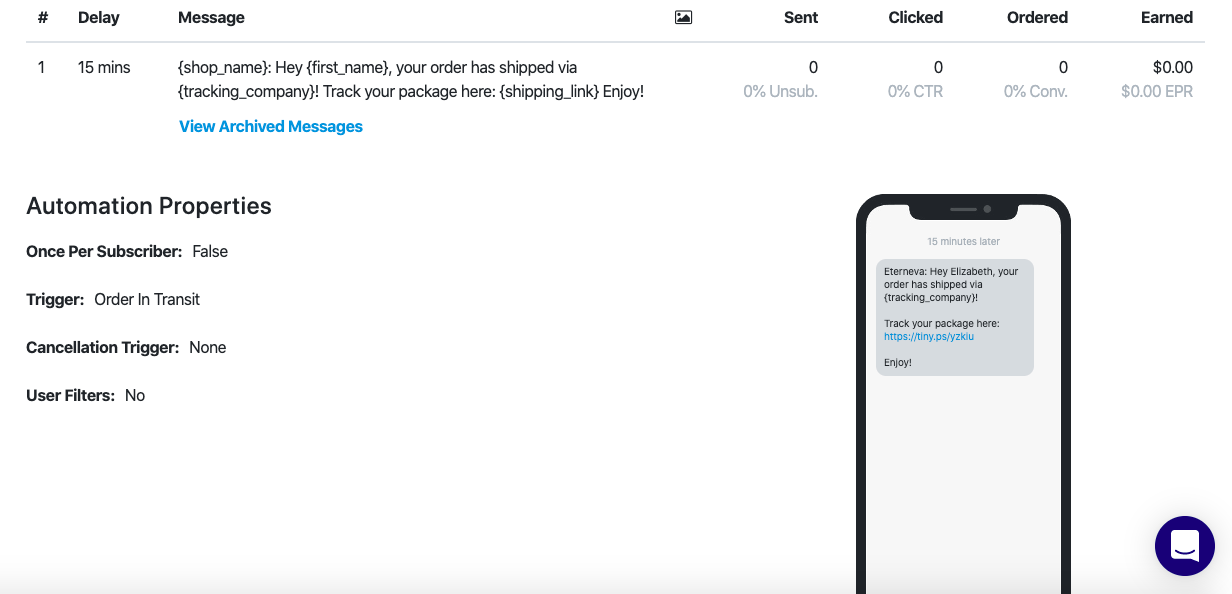
4. Welcome Series
Finally, the Welcome Series SMS marketing approach. This recipe and workflow is an introduction to your brand, both in terms of value and in getting new fans and customers used to your texting communication.
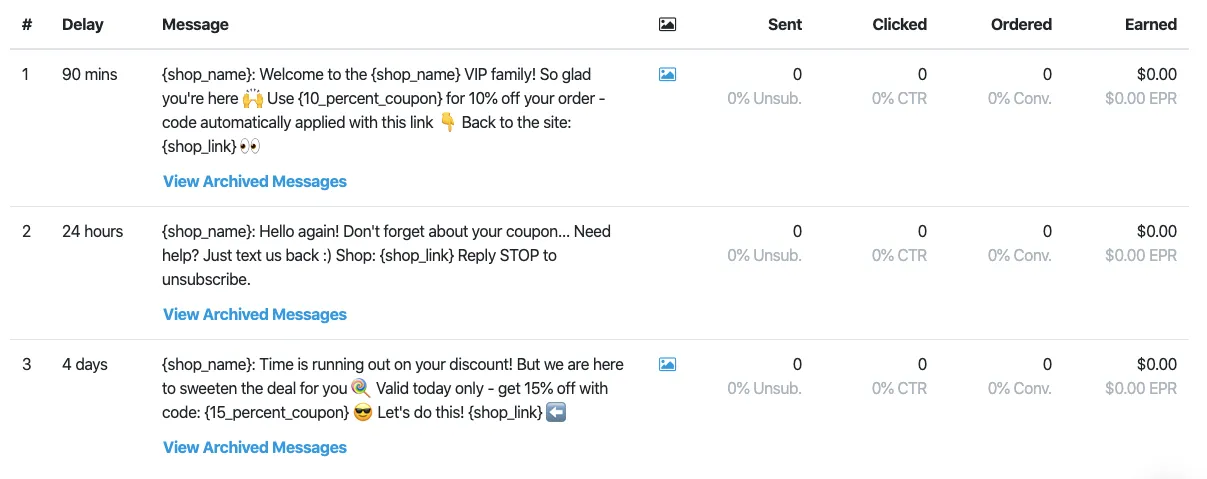
All messages here can and should be customized, but the workflow is already built out.
Putting it All Together
Don’t believe it can be this easy to launch your SMS marketing strategy? Get yourself a 30-day free trial of Postscript and see for yourself. Test it out. Use the built-in metrics to track success. If it doesn’t work and you aren’t seeing at least a 15% increase in engagement, turn it off. It's that easy.
Launching SMS marketing at your ecommerce brand?
Now is the time to start. And you are more prepared than ever. Whether you launch a simple welcome series SMS marketing strategy (and follow up with weekly newsletter-like texts or use SMS for your VIP customers), or you choose to follow a drop strategy with SMS marketing as your push tool — the possibilities, and the consumer attention, is endless.
Right now, that is. As new channels launch in the ecommerce space, it is the early adopters who often see the biggest gains. Build your brand off of an SMS marketing strategy. Build trust. Build the list. Build personalization. And then confidently grow sales through a text channel to 10x your other marketing channels.
Your next step from here is building out templates and copywriting to create engagement with your SMS messages. Start with our SMS templates for ecommerce brands, and then personalize them to your brand’s unique personality, point of view, and more.
Access premium content. Become an SMS expert.
Join over 10,000 other marketers who get weekly insights delivered directly to their inbox.
We are big fans of privacy. See our Privacy Policy for more information.

